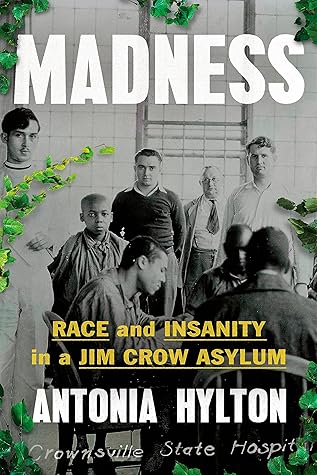More on this book
Community
Kindle Notes & Highlights
Read between
February 15 - March 7, 2024
According to the National Alliance on Mental Illness, an estimated one in five adults and one in six children in our country experience mental illness in a given year.
“There’s an assumption,” she told me, “that when a Black kid comes to the emergency department, the problem is behavioral. It’s not depression.”
The conditions of his segregated confinement at the hospital had been justified by white politicians and doctors as necessary, fueled by a century-long belief that newfound freedom had increased the rates of insanity among Black people.
Throughout the 1850s and 1860s, Maryland lawmakers passed resolutions that barred Black people from assembling for religious events, owning dogs or guns, or being educated, and that limited job opportunities. It was a ban from self-protection, growth, and hope.
By the early twentieth century in Baltimore, it became illegal for a white person to move onto a street that was more than 50 percent Black and illegal for a Black person to move onto a street that was more than 50 percent white.
“Drapetomania,” he asserted, was the irrational and unnatural desire of a slave seeking freedom. If slaves didn’t have white people to take care of them, they would regress. He believed that enslaved people who misbehaved and ran away from their owners would develop drapetomania, and that slave owners who treated the enslaved with too much kindness could trigger it.
The possibility that physical abuse, forced labor, and being owned by another human might produce mental trauma was not of scientific concern.
Maryland’s Eastern Shore—the birthplace of Frederick Douglass—was home to breeding farms, where owners forced their slaves to reproduce children for sale across the South.
It would be the first and only asylum in the state, and likely the nation, to force its patients to build their own hospital from the ground up. Black Marylanders would have to earn their access to healthcare through hard labor and a return to the antebellum social order.
What does it mean to be healthy and well enough to clear the woods, build a road, and construct a hospital, yet also be so sick you require institutionalization? How do we decide who’s irredeemable and who’s capable of recovery? What role have men like Robert Winterode played in alienating Black patients from therapy and care?
The function of lynching was so much more than a bypassing of the justice system. It was a form of psychological terrorism. And it sent several messages. One basic message was that they had killed people like Williams and Armwood before and, if necessary, would do it again.
But the more subtle and crucial message was that they still owned Black people. That they could sever their body parts, and continue to have complete and utter dominion. They controlled their livelihoods and their prospects. They could take ownership of people seen as destitute, different, and strange. They also owned the narrative. Each lynching stole the life of its victim, but it also wrought immeasurable trauma on every Black person who witnessed or heard the story.


